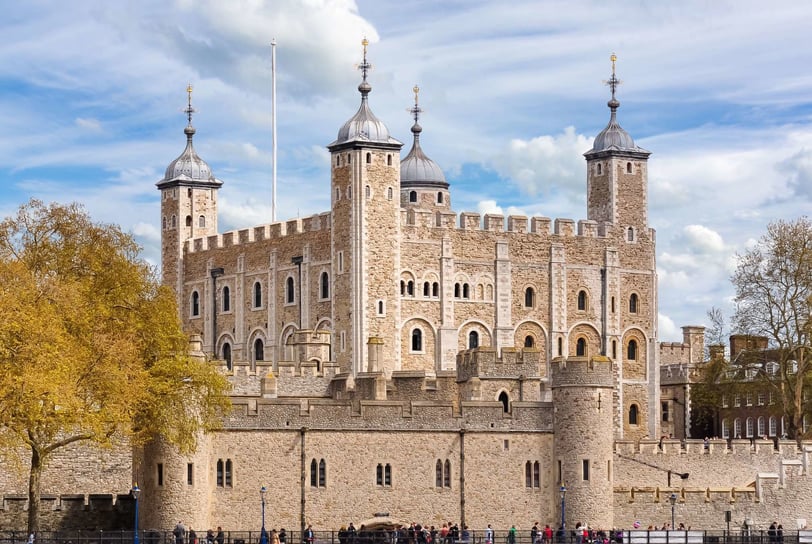A Thousand Years of Tales: More Than Just a Castle
William the Conqueror recognized the strategic importance of this location, building the initial White Tower as a symbol of Norman power and a defensive stronghold against a potentially rebellious populace. However, the Tower's story stretches far beyond its initial purpose.
THINGS TO DO


Standing proudly along the banks of the River Thames, the Tower of London is one of the city’s most iconic and storied landmarks. With nearly a thousand years of history woven into its ancient stone walls, this UNESCO World Heritage Site has served as a royal palace, fortress, prison, and even a zoo.
For first-time visitors, the Tower offers a captivating journey through the darker, fascinating corners of British history—from the Crown Jewels to tales of royal intrigue and infamous executions.
William the Conqueror recognized the strategic importance of this location, building the initial White Tower as a symbol of Norman power and a defensive stronghold against a potentially rebellious populace.
However, the Tower's story stretches far beyond its initial purpose:
A Royal Residence: While it's true that kings and queens resided within its walls, life at the Tower wasn't always glamorous. Over time, security concerns led monarchs to favor residences like Westminster Palace and Hampton Court, relegating the Tower to primarily a fortress and state prison.
However, key events still occurred there, such as coronations being prepared within the Tower before grand processions to Westminster Abbey. Edward I extended the Tower's fortifications in the late 13th century, creating the concentric rings of walls and towers we see today.
A Prison: The Tower was a prison of last resort, usually reserved for those of high status who posed a significant threat to the crown. Life within its walls varied greatly. Wealthy prisoners could bring servants, furniture, and even enjoy fine food. Poorer prisoners faced harsh conditions, cramped cells, and the constant threat of disease.
Infamous prisoners include:
Sir Walter Raleigh: Imprisoned by James I, he spent over a decade in the Tower and even wrote his History of the World there.
Anne Boleyn: Accused of treason, incest, and adultery by her husband Henry VIII, she was executed on Tower Green just three years after becoming Queen. Her ghost is said to haunt the Tower.
Thomas More: Imprisoned and executed for refusing to acknowledge Henry VIII as the Supreme Head of the Church of England.
Guy Fawkes: Tortured in the Tower for his role in the Gunpowder Plot, a failed attempt to blow up Parliament. His signature, barely legible after torture, can still be seen on his confession.
An Armoury: The Royal Armouries collection at the White Tower is a chronological journey through weaponry and armour. You can see the evolution of armour from the simple chainmail of the medieval period to the intricately decorated suits worn by Tudor monarchs. Highlights include:
Henry VIII's Armour: A collection of his armours, demonstrating his changing physique and taste.
Tournament Armour: Elaborate and often fantastical armour designed for jousting tournaments.
Ordnance: Cannons and other artillery, showcasing the development of siege warfare.
A Treasury: The Crown Jewels are a working collection still used for ceremonial occasions, including coronations.
Each piece is steeped in history:
St. Edward's Crown: The crown used for the actual moment of coronation, made of solid gold.
The Sovereign's Sceptre with Cross: Holding the Cullinan I diamond, the largest clear cut diamond in the world.
The Imperial State Crown: Worn by the monarch after the coronation ceremony and for state occasions, adorned with thousands of diamonds, sapphires, and other precious stones. It contains the Black Prince's Ruby, Edward the Confessor's Sapphire, and the Stuart Sapphire.
The Koh-i-Noor Diamond: A controversial gem with a long and contested history, now set in the Queen Mother's Crown.
A Menagerie (Some Bizarre Details): The Royal Menagerie began in the 13th century with gifts from foreign rulers. The lions were particularly popular, and the public could even pay to see them being fed. Some bizarre anecdotes include:
A keeper being attacked and killed by a lion in 1770.
A polar bear allowed to swim in the Thames River on a long leash.
The Menagerie's eventual relocation to Regent's Park Zoo in the 1830s.
Beyond Tourism: Still Relevant Today: Even though it is a major tourist attraction, the Tower still has ceremonial functions. It's still officially a Royal Palace, is used to store arms, and plays a central role in state occasions. The Garrison of the Tower of London continues to guard the site.
Key Highlights to Explore:
The White Tower: Climb to the top for panoramic views of London. Inside, marvel at the Royal Armouries collection, but also take time to appreciate the architectural details of St. John's Chapel. Note the rounded arches, typical of Norman design, and the simplicity and austerity of the space. This is one of the best-preserved examples of Norman church architecture in England.
The Crown Jewels (Insider Tip): Visit the Crown Jewels first thing in the morning or late in the afternoon to avoid the longest queues. Consider using the moving walkway to get a good view of the display.
Tower Green (More on the Executions): While Tower Hill, just outside the Tower, was the site of public executions, Tower Green was reserved for prisoners of royal blood or high status. It was considered a privilege to be executed privately, away from the jeering crowds. Anne Boleyn's executioner was brought from France especially for the occasion, as he was known for his skill and speed.
The Bloody Tower (Haunted History): Named for the alleged murder of the "Princes in the Tower," Edward V and his younger brother Richard, by order of their uncle Richard III. The truth of what happened to the princes remains one of history's great mysteries. Sir Walter Raleigh was also imprisoned here for many years.
Traitors' Gate (Reflecting on the Past): Imagine the fear and despair of those entering the Tower through Traitors' Gate. The river was the main thoroughfare for centuries, and this water gate was a symbolic entry point into the heart of the Tower's prison.
The Ravens (Ravenmaster Secrets): The Ravenmaster is responsible for the care of the Tower's ravens. Each bird has a name and personality. The Ravenmaster clips their wings to prevent them from flying away completely, ensuring the Tower's legendary protection. Ask the Ravenmaster questions if you see them – they're a wealth of knowledge! The current number of ravens is seven, with one extra.
These additions provide greater detail, richer historical context, and practical tips to enhance the visitor's experience at the Tower of London. It adds to the intrigue and helps the history come alive.
